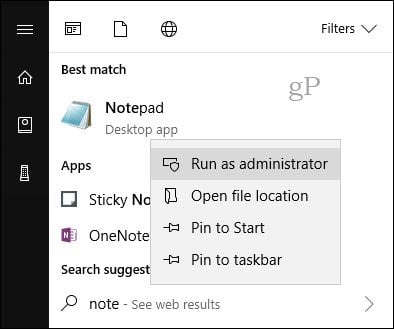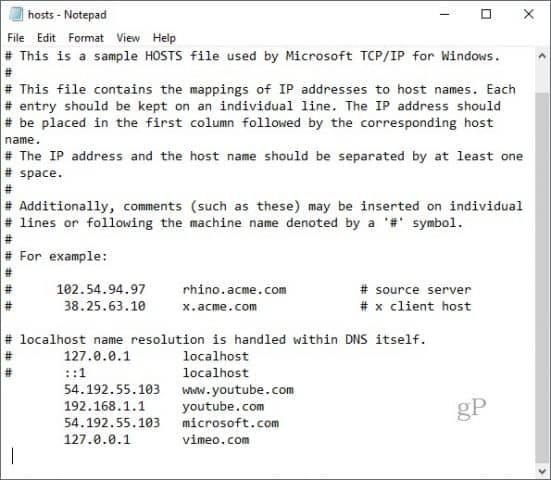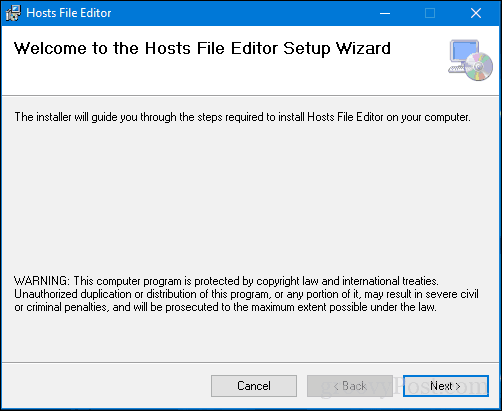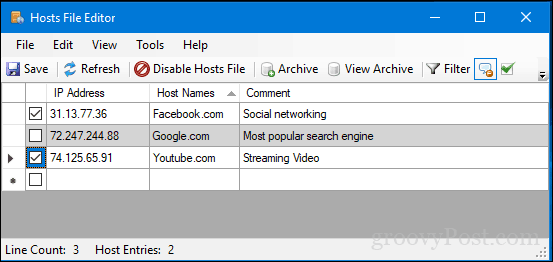As you can imagine, editing the HOSTS file can easily break your internet if it’s modified incorrectly or maliciously. So, it’s not particularly easy for a normal user to edit. This is a good thing. But if you want to change your HOSTS file purposefully, here’s how.
Edit Your Windows 10 Host File as an Administrator
The HOSTS file is normally stored in a plain text file in the Windows System folder and can be modified for various use cases. One particular reason I edited the Host file in the past was to block certain websites when I imaged computers for a local high school. This was probably one of the best and easiest ways I could ensure students didn’t load any unauthorized websites such as Facebook or YouTube. Editing your Windows Hosts file doesn’t have to feel like going down a rabbit hole. In Windows XP and earlier versions, the process was quite easy, add an exception to your antivirus, open it in Notepad, make your changes then save it. In Windows 10, if you try to edit your hosts file, you’ll probably be able to open it just fine, but when you go to save it, you’ll get an error:
Here’s how you can edit your hosts file without getting the “You don’t have permission to save in this location. Contact the administrator to obtain permission” error. Hit the start menu or press the Windows key and start typing Notepad. Right-click Notepad and choose Run as administrator.
In Notepad, click File then Open… In the File name field, paste the following path in: c:\Windows\System32\Drivers\etc\hosts
Now you’ll be able to edit and save changes to your HOSTS file.
To map a domain, add a line based on the examples in the HOSTS file. Start with the target IP address, then a space, then the domain name. If you want to block a website, redirect it to 127.0.0.1. Don’t put in the # if you want it to take effect. Also, remember that www.youtube.com is different than youtube.com. You may need to restart your computer for the new HOSTS file to take effect.
An Easier Way to Edit the Hosts File in Windows 10
If you found that process a bit cumbersome, there’s a third-party utility you can use to modify your HOSTS file. I found a good one called Hosts File Editor by Scott Lerch. Let’s take a look and see how it works. Now that you know the basics, here’s how you do it using the app, HOSTS File editor. Download the 1 MB installer, then proceed to set it up. Remember to choose the option just for yourself if you don’t want other users to access it.
Launch the app in Start > All apps—this will add the app to the Notification area, where you can launch the editor anytime you need to.
Hosts File Editor features a clean, easy-to-use interface. To begin using the program, populate the table with IP Addresses, Host Names, and comment on the websites you want to manage. It’s not just limited to popular Internet websites. Even devices on your home network with an IP address can be managed, so your Xbox, iPad, web cameras, or routers are much easier to block access to if needed.
When you are ready to block a website, check the box for the sites you want to prevent access to, click Save, and that’s it.
Another nice ease of use feature is the ability to right-click the Hosts File Editor in the Notification area, click Disable Hosts File, or make a quick edit. No need to go hunting or launch the command line anymore.
There are some other cool features included for power users and network administrators, such as:
Cut, copy, paste, duplicate, enable, disable and move one or more entries at a time.Filter and sort when there are a large number of host entriesArchive and restore various hosts file configurations when switching between environmentsAutomatically ping endpoints to check availability
So, there you have it, a quick and easy way to edit your Hosts File in Windows 10. Confirm you are Admin on the PC you’re trying to do this on. If you’re not an Admin, it won’t work. You can also try this: Click Start Button > Type: CMD > Right Click Command Prompt > Click Run as Administrator > goto c:\windows\system32\drivers\etc > type: notepad hosts Make your changes, save and you should be golden. Trying to set up a testing environment for a new website, I needed to add two local hosts in the hosts file. I ran into two problems. a) – The hosts file was not in drivers/etc/. FileFind did the job and found in some obscure location; maybe a backup inside windows. Opening the file there gave me the same screen as you show here, preventing me from editing. Not being a network ‘guru’, that looked like a lot of trouble. Never giving up. I have no choice. b)- once more looking in c:/windows/system32/drivers/ I was unable to find the directory /etc. Typed etc in de next step for opening a file. And that brought me to that invisible dir etc. And there was the hosts file too! After editing, I closed the file with just ‘save’, not ‘save as’. After that the hosts file was updated. Blocking unwanted sites is a great possibility, it stopps certain websites from following a user browsing the net. Happy with your help. Greeting from The Netherlands.
![]()










